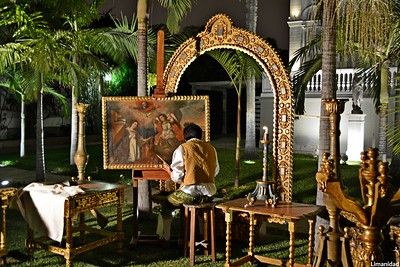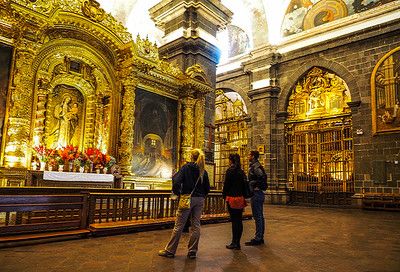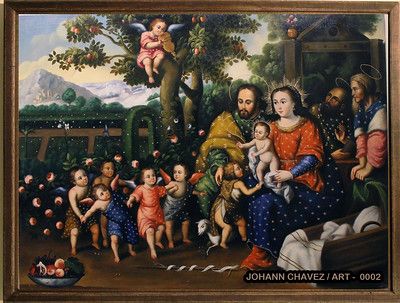(Diego Quispe Tito; 1611 – 1681) Peruvian painter of the 17th century, considered one of the most important exponents of the Cuzco school of painting.
His style, of Mannerist inspiration, was consolidated from the contemplation of engravings and tables by Flemish artists, such as Antonio Wierix or Ferdinand Bol.



Biography of Diego Quispe Tito
Diego Quispe Tito was born in San Sebastián del Cuzco in 1611 and died in Cuzco in 1681.
Documentary testimonies regarding the biography of Diego Quispe Tito are scarce; however, it can be said that he began his pictorial work around 1627, the date from which his first canvas dates and that it probably belonged to the indigenous nobility. Also that in 1667 he signed a painting indicating that he was 56 years old and according to tradition, his house and workshop are located in the town of San Sebastián.
Acoording to biography of Diego Quispe Tito, he established himself as a highly prestigious artist in the city of Cusco from the 1660s on, by intensifying his production for the temple of San Sebastián. It is from the virtuosity that he shows in the painting cycles that he produces for this temple that he gains the favor of the most important painting commissioners in Cuzco and Upper Peru, where he regularly sent paintings. In a painting that he sends to Potosí in 1667 he signed “Quispi Tito inga inbentado from the year D-1667, age 56”, 1 a way to highlight the creative and cultured aspect of his work.
He was a follower of Gregorio Gamarra, who in turn was a disciple of Father Bernardo Bitti. His painting had two stages. In the first, his painting was characterized by having certain remnants of Mannerism, while in the second, the influence of Flemish engravings can be seen in his painting. However, he is a painter who is somewhat outside the prevailing style in the city of Cuzco and who ends up developing and imposing a new style on painting in the region. He implants the use of large landscapes full of flowers and animals that later become characteristic of Cuzqueña Painting.
Art of Diego Quispe Tito
The documentary testimonies regarding art of Diego Quispe Tito are scarce but it can be said that his pictorial work began around 1627, the date from which his first canvas dates. He was a follower of Gregorio Gamarra, who in turn was a disciple of Father Bernardo Bitti.
The paintings of Diego Quispe Tito had two stages. In the first, his painting was characterized by having certain remnants of Mannerism, while in the second, the influence of Flemish engravings can be seen in his painting. His style, of Mannerist inspiration, was consolidated from the contemplation of engravings and tables by Flemish artists, such as Antonio Wierix or Ferdinand Bol.
In the Vision of the cross (1631) and the Ascension (1634), two of his first works, the linear schematization and the taste for the decorative elements characteristic of the mature works of this author of indigenous origin can already be seen. Native plants, flowers and birds are mixed with architectures drawn from European prints. This, together with a special attention to detail and the anecdotal, gave rise to a school that had a great impact on the Andean pictorial tradition. The Return from Egypt and the Last Judgment are characteristic themes of art of Diego Quispe Tito.
In the church of San Sebastián (Cuzco) a series of canvases on the life of Saint John the Baptist are preserved, made around 1663 based on the engravings of Cornellis and Phillipe Galle.
Diego Quispe Tito‘smasterpiece of art is the Zodiac, scenes from parables and the life of Christ that can be seen today in the Archbishop’s Palace in Cuzco (1681). It is a series of paintings intended to combat idolatry in which each sign corresponds to a biblical parable. This Zodiac series is currently made up of nine canvases, each one corresponding to a zodiac sign with a parable of the life of Christ.
Paintings of Diego Quispe Tito
Diego Quispe Tito was one of the best Indian painters of the Cusco school:
‘’He was the most important Cuzco painter of the s. XVII, which starting from Mannerism (see MANNERISM I B) came to create a local style that was characteristic of what was later called the “Cuzco school of painting”. (GER Encyclopedia 2010)
His originality was what made paintings of Diego Quispe Tito so important.
Some of the characteristics of paintings of Diego Quispe Tito, which began to be used more frequently since then, are the freedom in managing perspectives and the abundance of birds in leafy trees. The use of these animals, especially jungle parrots, is interpreted by some researchers as a secret sign that would represent the Inca nobility or the Andean resistance. The most valuable works of this Indian painter are in the church of his hometown: San Sebastián. Some of his most important paintings of Diego Quispe Tito are:
- The vision of the Cross
- The Return from Egypt
- The zodiac sign
The zodiac sign
It is currently composed of nine canvases, each corresponding to a sign
- Aries: Saint Joseph and the Virgin looking for an inn. Luke 2
- Cancer: Parable of the man who builds the barn
- Leo: Parable of the good shepherd. John 10
- Libra: Parable of the barren fig tree. Luke 13
- Scorpio: Parable of the unfaithful vineyards. Matthew 21
- Sagittarius: Parable invited to the wedding. Matthew 22
- Capricorn: Parable of the sower. Luke 8
- Aquarius: Flight to Egypt of the Holy Family. Matthew 2
- Pisces: Vocation of the Apostles. Mark 1










